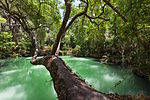Osteen, Florida

Osteen is an unincorporated community in southwest Volusia County, Florida, United States. Osteen is near the St. Johns River as well as typical swamps, forests and wildlife of Florida. Osteen attracts a number of visitors for these qualities. There are numerous camping areas and preserves such as the Hickory Bluff Preserve, a 150-acre nature preserve with hiking and horse trails.The Osteen Bridge spans the St Johns River near State Road 46 to the south near the Orlando Sanford International Airport. Sanford and Lake Monroe border the community to the west, with Deltona to the north and the small community of Farmton to the east. The north-south route of mostly two-lane State Road 415 serves as the main artery through Osteen. It connects State Road 44 in Volusia County to State Road 46 in Seminole County. State Road 415 is a two-lane road from State Road 44 until just north of Osteen. The road was recently four-laned beginning approximately three-miles north of Osteen and running the distance to State Road 46.
Excerpt from the Wikipedia article Osteen, Florida (License: CC BY-SA 3.0, Authors, Images).Osteen, Florida
East Central Regional Rail Trail,
Geographical coordinates (GPS) Address Nearby Places Show on map
Geographical coordinates (GPS)
| Latitude | Longitude |
|---|---|
| N 28.846111111111 ° | E -81.1625 ° |
Address
East Central Regional Rail Trail
East Central Regional Rail Trail
32764
Florida, United States
Open on Google Maps





